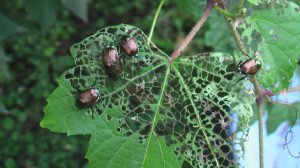It’s like clockwork: my raspberries finally ripen and the Japanese beetles return.
The beetles are known to devour hundreds of varieties of plants, turning leaves into skeletal “lace,” and raspberries – including the actual berries – appear to be among their favorites.
Related: Japanese beetle watch begins
I’ve tried picking the beetles off individually and knocking them into soapy water. Both work, but are time-consuming.
Debbie, from Illinois, recently wrote to offer another suggestion. Here is what she said: “I’m in Central Illinois and I can tell you for a fact that they are out in full force. At my place it happened within 3 days when I spotted the first couple beetles. Today, my rhubarb, a very large yellow apple tree, a linden tree and my asparagus patch are absolutely covered. They were swarming right outside my garage door at noon today.
“There are so, so many here right now that I have written off the rhubarb patch so I applied Sevin earlier, which seemed to have not much of an affect on them. About an hour after application the leaves of all plants were covered with live, breeding beetles. I just went out 30 minutes ago and sprinkled self rising flour on the rhubarb and the asparagus and sat back and watched. The beetles flying in are not landing and if they do, it’s short-lived. They leave. The others are dropping off. Too bad I can’t have a crop duster dump a load of flour on the entire property…”
The self-rising flour – said to burst the beetles’ digestive tracts when it’s ingested – sounds like it’s worth a shot and, at least, is a chemical-free alternative. If anyone else has suggestions for combating this invasive pest, please share a comment.


No Comments Yet